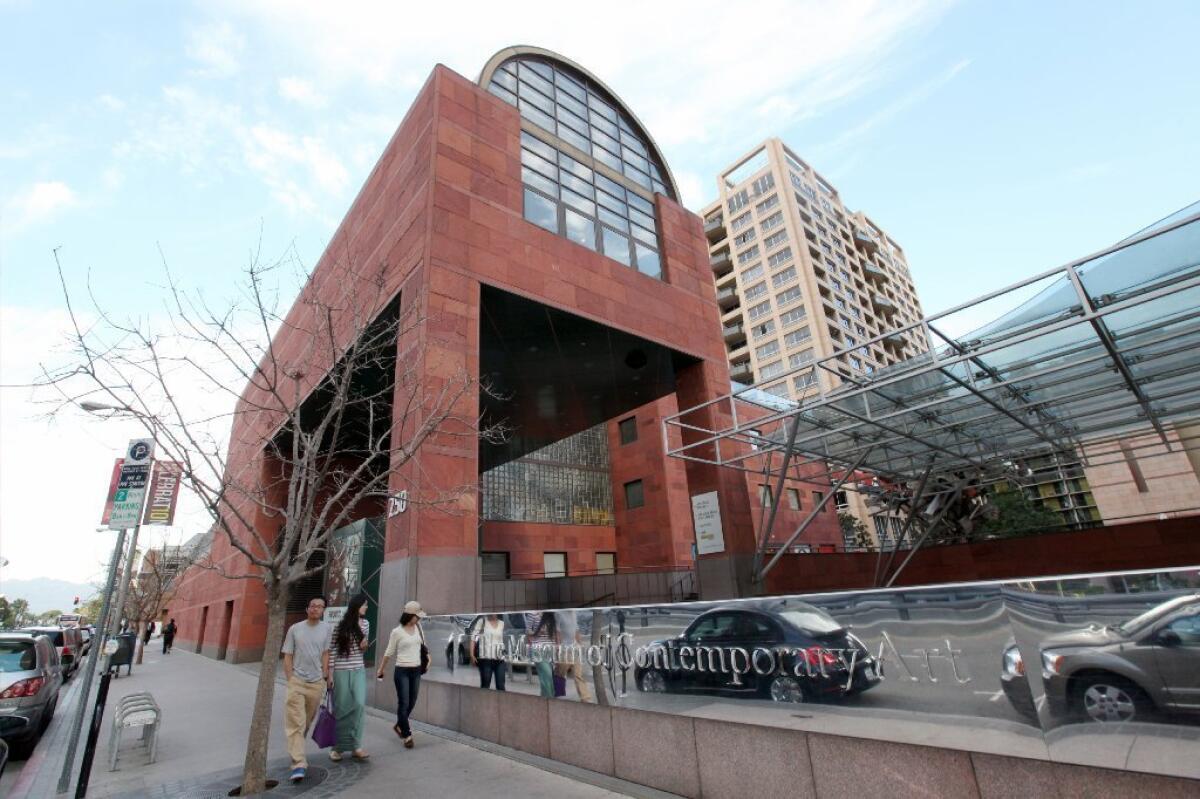MOCA names Philippe Vergne as new director

- Share via
The Museum of Contemporary Art has named Philippe Vergne as its new director, choosing a longtime art world professional from the respected Dia Art Foundation in New York to lead the financially challenged but rebuilding institution.
Vergne follows Jeffrey Deitch, who left MOCA in September 2013 with two years left in a five-year contract. Deitch was an unconventional choice when he was appointed in 2010 — a successful New York art dealer and advisor with no experience leading a nonprofit organization. And his tenure was a rocky one.
In replacing Deitch, the museum’s board chairs, Maria Bell and David Johnson, along with Andy Warhol Foundation director Joel Wachs, led a search committee that included artists John Baldessari, Barbara Kruger, Catherine Opie and Ed Ruscha. The artists had resigned from the MOCA board in 2012, criticizing the direction the museum was headed under Deitch. All four issued statements supporting Vergne’s selection.
“My vision is to commit to the most experimental artists of our time, but also to contextualize their work within a broader context,” Vergne said in an interview. “And I think Moca’s collection is one of the best to contextualize that kind of experimentation.”
In addition to his five years at Dia, Vergne, 47, has served as chief curator and deputy director of the Walker Art Center in Minneapolis, director of the Francois Pinault Foundation in Paris and director of the Musee d’art Contemporain in Marseille, France. He was born and educated in France.
He has organized exhibitions devoted to individual artists, group shows and shows organized by theme, and Vergne co-curated the 2006 Whitney Biennial.
GRAPHIC: MOCA’s ups and downs with Jeffrey Deitch
In its announcement, MOCA emphasized Vergne’s curatorial strengths and said he had “strong fundraising skills,” both of which he’ll need to address MOCA’s nearly blank slate of upcoming exhibitions and its depleted staff.
Vergne addressed MOCA’s need for a strong fundraiser: “We’ve raised significant money in a very discrete way to secure the Dia Art Foundation…the budget has been balanced for as long as I have been at Dia. You will see very soon that this effort and fundraising results [at MOCA so far] are bearing fruits.”
Vergne angered many last summer when the Dia Art Foundation announced it would sell nearly 30 works from its collection by Modern masters Cy Twombly, John Chamberlain and Barnett Newman. The most important was a suite of 24 Twombly drawings, “Poems to the Sea” (1959), that had been in Dia’s collection for more than 30 years.
Sotheby’s auction house described the group as “widely recognized as among the artist’s foremost triumphs and [a] critical early touchstone for the subsequent evolution of his entire career.”
Dia founders Heiner Friedrich and Fariha de Menil Friedrich vigorously objected to the proposed deaccession, meant to establish an endowment for new acquisitions, and briefly considered a lawsuit to prevent it.
Sotheby’s estimated the drawings would bring $6 million to $8 million at auction, but when the hammer fell in November they fetched $21.7 million with buyer’s premium. The income is expected to partly defray the cost of acquiring 30 contemporary works from the Lannan Foundation, formerly headquartered in Los Angeles, which have been on extended loan to Dia’s museum in Beacon, N.Y.
Vergne’s appointment means that two Los Angeles museums are headed up by former Dia directors: Michael Govan left the institution in 2006 to be director of the Los Angeles County Museum of Art.
After several lackluster fundraising years, budget cuts and layoffs under Deitch, and an unsuccessful bid by LACMA to take over the downtown institution, the MOCA board decided in March to keep the museum independent, setting a goal of quintupling its endowment to $100 million. The museum announced earlier this month that it had reached that, and had decided to keep raising money toward a new goal of $150 million.
“He’s charming, yet he’s strong and independent. I think he has the independence to say ‘no’ at times, and I think that’s a very strong quality to look for in a director,” Wachs said of Vergne. “We started with a list of over 50, and he really emerged as a person who was perfect for this job...as having the qualities the museum really needs at this time.”
Hugh Davies, longtime director of the Museum of Contemporary Art, San Diego, says he has met Vergne and followed his career.
“It’s very healthy and it’ll go a long way to restoring the credibility MOCA has had, and attracting the support of artists and potential donors,” Davies said. “It feels like the crisis is at an end. I will sleep better knowing that MOCA has a good director.
Times art critic Christopher Knight contributed to this report.
More to Read
The biggest entertainment stories
Get our big stories about Hollywood, film, television, music, arts, culture and more right in your inbox as soon as they publish.
You may occasionally receive promotional content from the Los Angeles Times.












